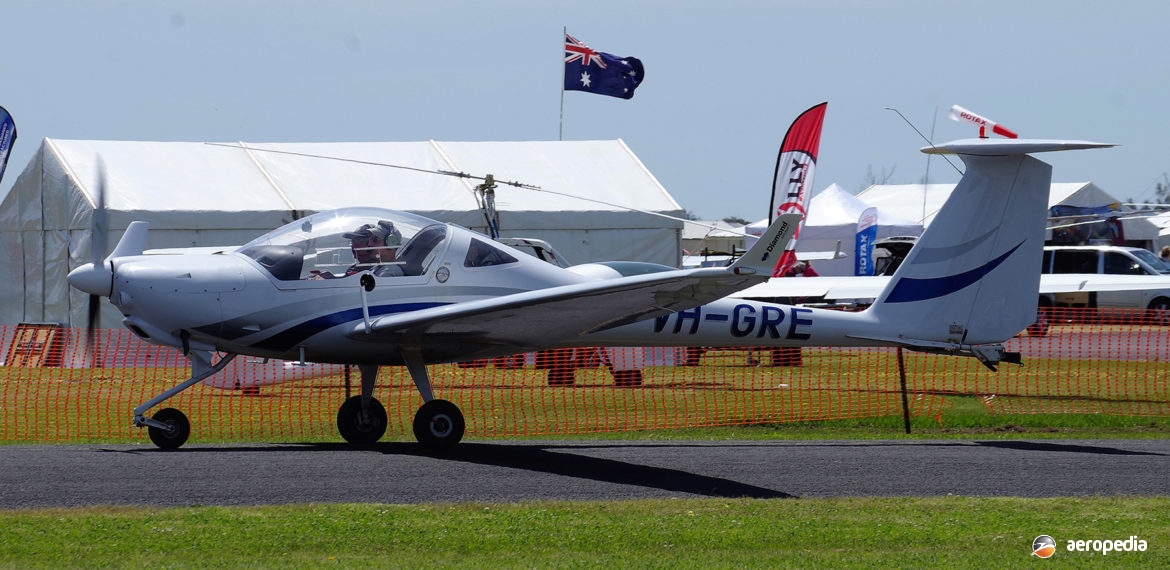Photograph:
Diamond HK-36TTC Dimona VH-GRE (c/n 36.857) at Narromine, NSW in 2016 (David C Eyre)
Country of origin:
Austria
Description:
Two-seat light sport aircraft and high-altitude research aircraft
Power Plant:
One 86 kw (115 hp) Rotax 914S turbocharged four-cylinder horizontally-opposed, liquid-and-air-cooled engine driving a constant-speed propeller
Specifications:
- Wingspan: 16.33 m (53 ft 7 in)
- Length: 7.28 m (25 ft 7 in)
- Max speed (vne): 260 km/h (162 mph)
- Max cruising speed: 217 km/h (135 mph)
- Ceiling: 7,000 m (22,966 ft)
- Endurance: 8 hours
- Range: 1,500 km (932 miles)
- Empty weight: 636 kg (1,402 lb)
- Scientific payload: 120 kg (665 lb)
- Loaded weight: 930 kg (2,050 lb)
History:
Hoffman Flugzeugbau was founded in 1981 in Friesach, Austria, to produce the H-36 Dimona motor glider. By 1985 the Company had become a subsidiary of Simmering-Graz-Pauker AG and, after moving to Vienna, introduced the Dimona Mk II. A production facility was established at Wiener Neustadt airport, and in 1991 the company name was changed to HOAC AG. In 1998 the company was re-named Diamond Aircraft GmbH to meet the requirements of the US market, and a production facility was set up at London in Ontario, Canada, known as Diamond Aircraft Canada.
The HK-36TTC-ECO was a special mission variant of the Dimona which first entered service in 1998, and was known as SERA, or small environmental research aircraft. It was designed as a platform for airborne research and science applications. The aircraft was certified to operate day and night VFR operations. Electrical power for the equipment was via dedicated 28V DC, 12V DC and 240V AC systems, providing a total of 1,000 W. Two underwing pods could carry a maximum of 55 kg (121 lb) of equipment each and were suitable to carry 48 cm (19 in) rack mounted instruments. There was also room for approximately 30 kg (66 lb) of instruments in the luggage rack in the cockpit.
The two Australian HK-36TTC-ECOs could carry a further 50 kg (110 lb) of scientific payload in a belly pod. There were also fittings on the wingtips and on the cockpit roof for light scientific instruments. These aircraft have carried equipment for atmospheric and environmental research, often carrying unique instrumentation worth hundreds of thousands of dollars during national and international science programs taking measurements which, until recent years, have required large, expensive multi-engine aircraft to perform.
A total of seven examples of the HK-36TTC-ECO-Dimona was constructed, two of these being imported to Australia for operation by the Flinders University in South Australia (Airborne Research Australia), operating out of Parafield, together with other research aircraft, becoming VH-EOS4 (c/n 36644 – ex N846WS, C-GEPR) on 6 November 2003 and VH-OBS² (c/n 36642 – ex N843WS, C-GETD) on 9 September 2004. The University also operated for some years a Grob G520T Egrett and a specially modified Grob G-109B VH-HNK (c/n 6262) registered in September 1985.
In later times new equipment has been fitted to the Australian HK-36TTC-ECOs, this being for remote sensing of soil moisture in the root zone, and sea surface salinity, as well as airborne laser scanning, this program being performed in conjunction with partners at Melbourne University, the University of Newcastle, James-Cook University, RMIT, and the University of Adelaide.
Other HK-36TTCs known to be in operation have included HB-2335 (c/n 36581) with MetAir AG in Switzerland; G-GEOS (c/n 36643) with the University of Edinburgh inScotland, this aircraft at one stage being operated in Japan as JA07EC. Two have remained with the manufacturer in Wiener Neustadt in Austria and one of these is currently operational. One HK36-TTC is known to have operated as N595TT (c/n 36595) in the United States.
A HK-36TTS Super Dimona became VH-EKS³ (c/n 36584 – ex D-KLWG) on 19 April 2016 to the Barossa Valley Gliding Club at Stonefield, SA and further examples have been imported for private use as sport aircraft.

